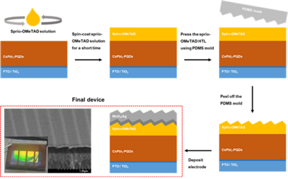Home > Press > Key in increasing efficiency of next-generation solar cell, found in light absorption capacity!
 |
| Credit: DGIST (Daegu Gyeongbuk Institute of Science and Technology) |
Abstract:
On the 11th (Wednesday), DGIST announced that the research team led by Professor Choi Jong-min of the Department of Energy Engineering at DGIST (President: Kuk Yang) enhanced light absorption capacities and photocurrent generation of solar cells by implementing a nano-structured electrode on the back of the perovskite quantum dot solar cell, which is in the limelight as a next-generation solar cell. In addition, the team has systematically verified the correlation between the shape of the nanostructure and the efficiency of the solar cell and the optimized conditions for the formation of nanopatterns in organic materials. It is expected that the teams achievements can be applied to various photoelectric devices using organic materials.
Key in increasing efficiency of next-generation solar cell, found in light absorption capacity!
Daegu, Korea | Posted on July 1st, 2022
Interest in solar cells, which is a new renewable energy source, has been building up recently. Research on solar cells using quantum dots is also active. In particular, in the field of quantum dot solar cells, perovskite quantum dot solar cells have recently been in the spotlight as a next-generation solar cell because energy generation efficiency is rapidly increasing.
□ The efficiency of a solar cell is mainly determined by its ability to absorb light and transmit electric charges generated by light to the electrode. Although perovskite quantum dots have excellent photoelectric properties, they have limitations in generating photocurrent as they do not form a thick light absorption layer when manufacturing a solar cell.
□ Meanwhile, the research team led by Professor Choi Jong-min of the Department of Energy Engineering at DGIST succeeded in enhancing light absorption and photocurrent while maintaining the thickness that optimizes the amount of charge extraction by forming the rear electrode of the perovskite quantum dot solar cell into a nanostructure. The research team successfully embodied a rear nanostructure electrode by forming a nanopattern on the hole transport layer of a perovskite quantum dot solar cell through a nanoimprint lithography and uniformly depositing an electrode material on top of it along the curves of the hole transport layer nanopattern.
□ In addition, the research team formed nanostructured rear electrodes of various heights and cycles to verify the relationship among the shape of the nanostructure, the light absorption ability, and the electrical loss of the solar cell due to nanostructure. Afterwards, the team designed optically and electrically effective nanostructured rear electrodes and optically enhanced the light absorption capacity of the solar cell and maximized the efficiency of the solar cell without electrical loss.
□ In addition, the team verified the optimal conditions for nanoimprint lithography based on the relationship between the glass transition temperature and flexibility of organic materials, which are widely used as charge transfer materials for photoelectric devicess including solar cells. These achievements are expected to contribute to research on the formation of nanopatterns of various photoelectric devices using organic materials as charge transport layers in the future.
□ Meanwhile, this research is the result of a joint research conducted with Professor Kim Yeong-hoon’s team at Kookmin University and Professor Baek Se-woong’s team at Korea University and was led by Han Sang-hoon, a Combined Master/Ph.D. student at DGIST. In addition, this study was funded by the National Research Foundation of Korea, the DGIST R&D Program, and new research project subsidy provided by the National Research Foundation of Korea.
Correspondence Author Email Address :
####
For more information, please click here
Contacts:
wanghoon CHOI
DGIST (Daegu Gyeongbuk Institute of Science and Technology)
Office: 82-537-851-133 x1133
Copyright © DGIST (Daegu Gyeongbuk Institute of Science and Technology)
If you have a comment, please Contact us.
Issuers of news releases, not 7th Wave, Inc. or Nanotechnology Now, are solely responsible for the accuracy of the content.
News and information
![]()
Two opposing approaches could give lithium-sulfur batteries a leg up over lithium-ion July 1st, 2022
![]()
Efficiently processing high-quality periodic nanostructures with ultrafast laser July 1st, 2022
![]()
Photonic synapses with low power consumption and high sensitivity are expected to integrate sensing-memory-preprocessing capabilities July 1st, 2022
Possible Futures
![]()
Sieving carbons: Ideal anodes for high-energy sodium-ion batteries July 1st, 2022
![]()
An artificial intelligence probe help see tumor malignancy July 1st, 2022
![]()
Photon-controlled diode: an optoelectronic device with a new signal processing behavior July 1st, 2022
Discoveries
![]()
Sieving carbons: Ideal anodes for high-energy sodium-ion batteries July 1st, 2022
![]()
Efficiently processing high-quality periodic nanostructures with ultrafast laser July 1st, 2022
![]()
Photonic synapses with low power consumption and high sensitivity are expected to integrate sensing-memory-preprocessing capabilities July 1st, 2022
Announcements
![]()
Two opposing approaches could give lithium-sulfur batteries a leg up over lithium-ion July 1st, 2022
![]()
Efficiently processing high-quality periodic nanostructures with ultrafast laser July 1st, 2022
![]()
Photonic synapses with low power consumption and high sensitivity are expected to integrate sensing-memory-preprocessing capabilities July 1st, 2022
Interviews/Book Reviews/Essays/Reports/Podcasts/Journals/White papers/Posters
![]()
Sieving carbons: Ideal anodes for high-energy sodium-ion batteries July 1st, 2022
![]()
An artificial intelligence probe help see tumor malignancy July 1st, 2022
![]()
Photon-controlled diode: an optoelectronic device with a new signal processing behavior July 1st, 2022
Energy
![]()
Solving the solar energy storage problem with rechargeable batteries that can convert and store energy at once June 24th, 2022
![]()
Organic water splitters get a boost June 10th, 2022
Solar/Photovoltaic
![]()
Solving the solar energy storage problem with rechargeable batteries that can convert and store energy at once June 24th, 2022
![]()
USTC found a pathway to high-quality ZnSe quantum wires April 8th, 2022
![]()
Graphene crystals grow better under copper cover April 1st, 2022
![]()
Peering into precise ultrafast dynamics in matter March 25th, 2022










